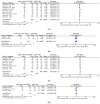Investigating the Efficacy of EGFR-TKIs and Anti-VEGFR Combination in Advanced Non-Small Cell Lung Cancer: A Meta-Analysis
- PMID: 38539522
- PMCID: PMC10969009
- DOI: 10.3390/cancers16061188
Investigating the Efficacy of EGFR-TKIs and Anti-VEGFR Combination in Advanced Non-Small Cell Lung Cancer: A Meta-Analysis
Abstract
Introduction: The epidermal growth factor receptor tyrosine kinase inhibitors (EGFR-TKIs) in combination with anti-vascular endothelial growth factor receptor (VEGFR) agents have shown improved survival outcomes in recent studies. However, its efficacy related to survival outcomes as a first- or second-line agent and based on generations remains to be explored. This study estimated the survival outcomes of EGFR-TKIs plus anti-VEGFR in combination in defined populations of advanced non-small cell lung cancer (NSCLC) patients overall, as a first- or second line of treatment, with different generations of EGFR-TKIs and EGFR-TKIs plus bevacizumab combination as a subgroup.
Methods: A literature search was conducted using PubMed, SCOPUS, Cochrane Library, and ClinicalTrials.gov databases through June 2023 to identify primary research reporting the survival outcomes of EGFR-TKIs in combination with anti-VEGFR agents in patients with advanced NSCLC. Studies that were single-arm, published in non-English languages, and had missing data on survival outcomes were excluded. A meta-analysis was conducted to generate pooled hazard ratios (HRs) with 95% confidence intervals (CI) for overall survival (OS) and progression-free survival (PFS). Methodological quality and risk of bias in studies were assessed using the Cochrane Handbook for Systematic Reviews of Interventions risk of bias tool.
Results: A total of 20 randomized controlled trials were included in the qualitative synthesis, and 11 (2182 participants) were included in the meta-analysis. Patients' median age ranged from 58 to 68 years; 36% to 70% of patients were female; most of them had IIIa/b to IV stage cancer. In meta-analyses, the EGFR-TKIs plus anti-VEGFR combination resulted in improved PFS (HR, 0.73; 95% CI: 0.61, 0.86; p < 0.00001) in patients with advanced NSCLC but had no impact on OS (HR, 0.93; 95% CI: 0.79, 1.10; p = 0.41). The first line of treatment and first-generation EGFR-TKIs with the combination also improved the PFS (HR, 0.64; 95% CI: 0.57, 0.71; p < 0.00001; HR, 0.63; 95% CI: 0.56, 0.71; p < 0.00001) respectively, however, had no impact on OS.
Conclusions: Our meta-analysis indicated EGFR-TKIs with anti-VEGFR in combination not only improved overall PFS but also showed similar results to a first line and first-generation agent compared to EGFR-TKI alone.
Keywords: EGFR-TKIs; NSCLC; anti-VEGFR; bevacizumab; epidermal growth factor receptor; epidermal growth factor receptor tyrosine kinase inhibitors; erlotinib; non-small cell lung cancer; tyrosine kinase inhibitors; vascular endothelial epidermal growth factor receptor.
Conflict of interest statement
The authors declare no conflicts of interest.
Figures









References
-
- American Cancer Society Cancer Facts & Figures. 2023. [(accessed on 4 December 2023)]. Available online: https://www.cancer.org/research/cancer-factsstatistics/all-cancer-facts-....
Publication types
LinkOut - more resources
Full Text Sources
Research Materials
Miscellaneous

